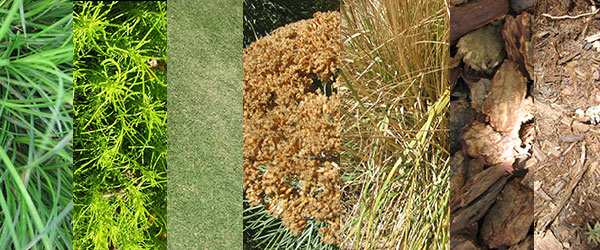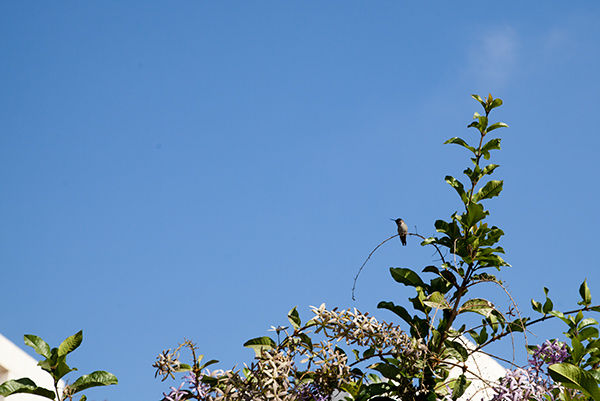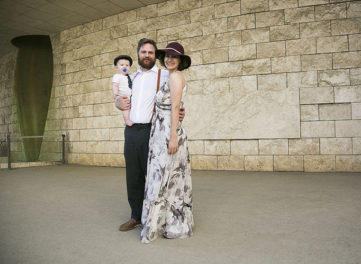
Gorilla Hair was not part of artist Robert Irwin’s original plan when he designed the Getty Center’s Central Garden in the early 1990s. Made of shredded redwood, the oddly named mulch preserves moisture in soil and can replace grass. It is currently spread over several parts of the Getty gardens in a continuing attempt to use less water during California’s severe drought.
“When Robert Irwin selected the plants for his design, some of them were native or drought tolerant,” garden supervisor Michael DeHart told me. But others weren’t, and Michael has had to rotate out certain water-hungry flowers, like petunias and corn-cockle, replacing them with low-irrigation plants like purple cut-leaf daisies. On the Museum’s upper terrace, birds of paradise were removed and replaced with shrubs and succulents.

Delicate but drought-tolerant daisies now line the bowl garden around the Azalea Pool, taking the place of more water-intensive annuals

A small area of grass was replaced by mulch near the entrance to the Getty Research Institute
Fortunately, Irwin’s instructions for plantings are relatively flexible. He established distinct aesthetics for summer, spring, and winter plantings, with room for variation. For the first decade after the Central Garden opened, in 1997, Irwin was a frequent visitor and observer of its progress. He made a list of specimens he liked, and refined it over time based on which ones thrived and which ones struggled. “The one thing Irwin wouldn’t allow though, is pastels. No pastels!” laughs Michael.
Despite some changes to the Central Garden, much remains the same. The lawns alongside the zigzag path in the Central Garden are planted with short, tough Bermuda grass, which is the most resilient drought-tolerant option, and those lawns will remain lawnlike—a favorite site for picnics and rolling down the hill.

Gorilla Hair mulch contrasts with the bark of a plane tree along the Central Garden’s zigzag path

The new mulch also provides excellent camouflage for native wildlife, such as this western fence lizard
Although water has been turned off at several ornamental pools at the Villa and Center, recirculating water will continue to flow down the ravine into the Azalea Maze because the Central Garden is considered a vast outdoor sculpture. It’s even part of the Museum’s permanent collection.
Irwin was intrigued by the different challenges that working with plants—as a growing, changing, mortal material—offered. Planning the Central Garden caused him to reflect: “Gardening requires the ultimate hands-on, everyday ‘attending’…a process, where we optimistically set in motion our desires for how we want things to be…and in turn discover how things actually are…and then we learn to work at keeping them in play.” It seems especially fitting that the artist had the following phrases inscribed on a stone in the Central Garden’s path: “ALWAYS CHANGING / NEVER TWICE THE SAME.”

An Anna’s hummingbird enjoys the garden




Congratulations on the transition of much of the garden to more drought tolerant plants and mulch which did not really change the original design concept. I am a former college professor in horticulture and appreciate when one does the garden justice!
Seems so very sensible and responsible design decisions were made to reduce water consumption while maintains the garden’s aesthetics. I look forward seeing the work in progress.
It seems to me that the center has found the balance between the garden design and our new water reality,one more reason to visit this great place.
Congratulations,
FERNando
I truly appreciated this beautiful coverage of the Central Garden. I am an architecture and garden docent, and I love sharing these incredibly beautiful spaces with our visitors.
I love the new colors in the garden and love the fact that birds and lizards like it, too.
I think that the Getty made wise decisions about curtailing their water use and their action to do so informs others that gardens can still be inviting and inspiring without using much water.
As a local Horticulturist, I enjoy the Getty many times a year, and look forward to the new plantings of the interesting plant changes the hard working gardeners, magically, install, they do a fantastic job.
Lately I have been hearing a lot of negative responses about the look of mulch as an alternative to lawns and groundcovers. Mulched soils play a major role in maintaining a global carbon cycle. Soils with organic matter trap and absorb CO2, dirt (without organic matter) does not.
So the more you add mulch to your landscaping, not only do you help retain the soil moisture, add soil microbes, and give your plants better nutrients, you also helping with the decrease the CO2 in our atmosphere.
Thank you for this important information Kararina! Good to know that mulch does much more than just save water.